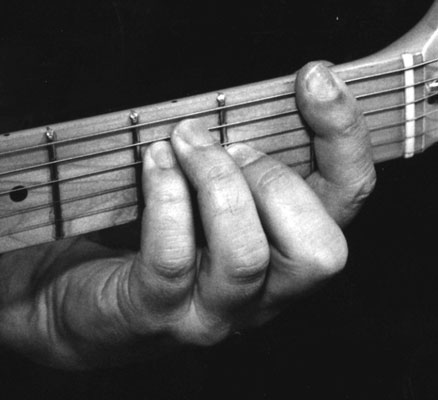Unlike the guitar's open-position chords, barre chords can move all around the neck of your guitar. A movable barre chord contains no open strings — only fretted notes. You can slide these fretted notes up or down the neck to different positions to produce other chords of the same quality.
One of the most useful movable barre chords is the one based on the open E chord. Barre chords get their names from the notes that you play on the 6th (low E) string. The best way to get a grip on this barre chord is to start out with an open-position E chord.
As you play a barre (pronounced “bar”), one of your left-hand fingers (usually the index) presses down all or most of the strings at a certain fret, enabling the remaining fingers to play a chord form immediately above (toward the body of the guitar) the barre finger. Think of your barre finger as a sort of movable nut or capo and your remaining fingers as playing certain open-position chord forms directly above it.
Play an open E chord, but instead of using the normal 2-3-1 left-hand fingering, use fingers 3-4-2.

This fingering leaves your first (index) finger free, hovering above the strings.
Lay your first finger down across all six strings on the other side of the nut (the side toward the tuning pegs).

Placing your index finger across the strings at this location doesn’t affect the sound of the chord because the strings don’t vibrate on that side of the nut, but it does give you the “feel” of a barre chord position.
Take the entire left-hand shape and slide it up one fret.

Your first finger should be barring the first fret, and your E-chord fingers should all have advanced up a fret as well. You’re now in an F-chord position (because F is one fret higher than E), and you can press down across all the strings with your index finger.
Try playing the notes of the chord one string at a time (from the 6th string to the 1st) to see whether all the notes ring out clearly.

The first few times you try this chord, the chances are pretty good that some of the notes aren’t going to ring clearly and that your left-hand fingers are going to hurt.
Because you can play an F chord as a barre chord, you can now, through the miracle of movable chords, play every major chord — all 12 of them — simply by moving up the neck. To determine the name of each chord, you simply have to know what note name you’re playing on the 6th (low E) string — because all E-based barre chords get their name from the 6th string (just as the open E chord does).
dummies
Source:http://www.dummies.com/how-to/content/how-to-play-ebased-major-barre-chords-on-guitar.html
No comments:
Post a Comment